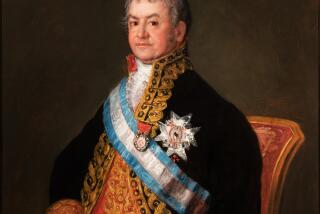Collector Reveled in Showing Art
Walter Annenberg liked nothing better than welcoming visitors to his estate in Rancho Mirage and showing off his collection of French Impressionist and Post-Impressionist paintings. Like a proud but rather reticent father, he would stand back and encourage his guests to simply look at the pictures and absorb their beauty.
Most visitors were thrilled to comply. The Monet landscapes, Gauguin Tahitian scenes, Bonnard interiors and a host of other glowing canvases painted by Matisse, Degas, Renoir, Cezanne and Van Gogh reflected the atmosphere of the estate, with the verdant grounds seen through the living room windows. More melancholy works, such as âAu Lapin Agile,â an early (1905) bar scene by Pablo Picasso, tempered the sunny mix with a touch of darkness and angst.
When the time seemed right and he could contain himself no longer, Annenberg would offer his own interpretations of the art. Gauguinâs âPortrait of Womenâ was actually a penetrating view of a daughterâs innocence and her motherâs hard-won wisdom, he said. Comparing a landscape and a still life by Cezanne, he noted the artistâs skill at adapting his formal vocabulary to different subject matter.
Annenberg collected more than 50 paintings and watercolors over about 30 years, often paying record prices for fine examples of the work of internationally renowned artists. Though his choices speak of a highly refined taste, he confessed to a weakness for artworks that appealed on sight and demanded that they radiate an emotional resonance. âThey have to move me,â he said of the paintings that found a place on his walls.
Much as he loved owning the artworks and displaying them in what amounted to a private museum, he came to the conclusion that âgreat works of art should ultimately belong to the people.â With that credo in mind, he bequeathed the entire cache, valued at $1 billion, to the Metropolitan Museum of Art in New York--ending a quiet but intense competition among directors and curators of other museums, which had heated up during a traveling exhibition of the collection in 1990-91.
âI love these works with a passion, and I want them to stay together after Iâm gone,â Annenberg said when he announced his gift in 1991. âMuch as I respect the other institutions that have lately shown our collection--the Philadelphia Museum of Art, the Los Angeles County Museum of Art and the National Gallery of Art in Washington--I happen to believe in strength going to strength, and I think that the Met is the proper repository for them.â
His gift greatly enhanced the Metâs collection of Impressionist and Post-Impressionist art, which was established in 1929 by a bequest from H.O. Havemayer and reinforced by major gifts and bequests from other collectors. Although the museum did not become the owner of Annenbergâs collection until he died, it was installed in three large galleries, which have become one of the most popular areas of the museum.
The Annenberg bequest âwas a quantum jump, qualitatively and quantitatively, to our collection of Impressionists and Post-Impressionists,â Philippe de Montebello, director of the Met, said. âOur collection was already strong. Itâs now clearly preeminent in the Western Hemisphere and right next to the Musee dâOrsay in Paris. It puts us in that league. Even for us, it made an enormous difference.â


